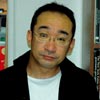仠 Christopher BANNERMANN
Christopher Bannerman is Head of ResCen, a research centre at Middlesex University, London that works with artists researching their creative processes. He had a long career as a dancer, choreographer and arts education worker and performed and choreographed internationally. He has served as Chair of Dance UK and the Arts Council of England乫s Dance Panel. He is currently Chair of London North Creative Partnerships; co-facilitator of Rural Retreats, a series of intensive seminars for leaders in the arts; a member of the Peer Review College of the AHRC, the College of Reviewers for the Canada Research Chairs Programme and is a member of the Dance Forum of the Department for Culture, Media and Sport (DCMS) UK.
仠 OHNO Noriko
She has been working at Sapporo Education and Culture Hall since 2000, managing projects such as festivals that are planned in collaboration with local theatre people and opera groups, operetta workshops for children, and noh performances. In order to enable new types of projects for the Hall, she joined the Master Course of Japan Foundation for Regional Art-Activities and is planning to create an opportunity for old people to encounter with dance as Sapporo version of 乬Dance Life Project,乭 a community dance project that is going to be held across Japan in 2008.

仠 SATO Norikazu
He joined butoh company 乬Byakkosha乭 in 1980 as both a dancer and company manager until it was dissolved in 1994. He studied arts management at the Dance Theater Workshop in New York in 1996 and worked on the Triangle Art Project that toured the United States of America, Indonesia and Japan in 2007. Then founding a non-profit organization, the Japanese Contemporary Dance Network (JCDN) in Kyoto in 2001, he has been organizing various activities that connect dance and society across Japan.
 仠March 6th [Thu] 18:30-20:30 / Visual Presentation area of Yebisu The Garden Room
仠March 6th [Thu] 18:30-20:30 / Visual Presentation area of Yebisu The Garden Room Speaker: Anders Ohrn
Speaker: Anders Ohrn
Centering on people, movement and time, dance films convey an unrivalled sense of the modern age. This selection of films presents choreographers, dancers and directors currently working in Sweden, each of whom exploit the artistic scope offered by new dance cinema in a unique way. They blend the transience of dance with the intimacy of film, experiment with the plastic dynamics of movement and montage, and explore both rhythm and visuality. Here, aesthetic expression rooted in the modern era takes the form of realism, absurdism and avant-gardism. Everything is possible!
乬The Rain乭 (2006) of Pontus LIDBERG
© Ralph Evers
仠 Anders OHRN
Coming from the international theater world, educated at Dell丩Arte School of Mime & Comedy, California USA and Ecole Philippe Gaulier, Paris France, with experiences both from acting and directing, as well as producing and as a creator of theatrical events, Anders Ohrn is currently holding the position as Project Manager at the Swedish Institute (www.si.se)
After founding the international touring theater company Tajphoon Tivoli in the early `80s, Mr. Ohrn has [among other] been; engaged as a producer at Nationalteatern, Gothenburg, touring with Compagnie Philippe Gaulier in Great Britain, directing at the City Theater of Stockholm, initiating the venue Pusterviksteatern in Gothenburg, and has been the Managing Director of the Modern Dance Theater in Stockholm.
 仠March 7th [Fri] 10:00-12:00 / Visual Presentation Area, Yebisu The Garden Hall
仠March 7th [Fri] 10:00-12:00 / Visual Presentation Area, Yebisu The Garden Hall Coordinator:
Coordinator:
KUSAKA Toshiya [Representative, Art Space Factory]
Panelists:
KODAMA Shin [Director, NPO Triton Arts Network]
TSUMURA Takashi [Chief Producer, Kitakyushu Performing Arts Center]
HATA Yukio [Director, Cultural Promotion Division, Asahi Sunrise Hall]
WATANABE Hiroshi [Director, Production Department, Saitama Arts Foundation]

Due to the recent drastic changes in the environment surrounding public cultural facilities, the main and management bodies of each facility are strongly required to reconfirm their missions and roles, according to which the halls should be managed and operated, along with an appropriate method to assess such activities. How to organize an annual program for the hall becomes one of the key elements when the facility aims to meet the abovementioned requirements. In this seminar, guests invited from public facilities around the country including halls, etc., where programming according to missions are actually carried out, will introduce their policies in planning and examples of programming. There will also be a simple lecture on practical knowledge including policy assessment that might be useful when programming. (Co-hosted by the Association of Public Theaters and Halls in Japan)
仠 KUSAKA Toshiya
After completing a master乫s course at Tokai University Graduate School majoring in architecture and building engineering, Kusaka joined Theater Engineering Research Institute Co., ltd. as a researcher. In 1989, he visited U.K. with the support of the Agency for Cultural Affairs乫 overseas study program for artists, returned to Theater Engineering Research Institute Co., ltd. as a senior researcher, and then founded Theatre Consultant Office. He currently serves as a public cultural facilities revitalizing advisor at the Association of Public Theaters and Halls in Japan, a member of the board of directors at Theater and Entertainment Technology Association, Japan, and the vice president at the International Organization of Scenographers, Theatre Architects and Technicians Japan Center.

仠 TSUMURA Takashi
After graduating Osaka University of Arts, Tsumura was in charge of planning for Play Guide Journal, an information magazine based in Osaka. In 1985, he launched the Ogimachi Museum Square project organized by Osaka Gas, and became the associate manager and producer of the venue. He has been working as the chief producer at Ai Hall in Itami, Hyogo Prefecture since 1987, and has been involved in activities of the Drama Department at Biwako Hall since 1997 as well. He belongs to Japan Foundation for Regional Art-Activities since 1995 as a producer of Arts Environment Division, and also serves as a chief producer at Kitakyushu Performing Arts Center where he has been totally producing both hardware and software aspects of the venue since 2000.

仠 HATA Yukio
After graduating Hokkaido Asahikawa Technical High School, Hata began working at Asahi Town Office. He was temporarily transferred to the board of education when a hall was opened in 1993. In September 2005, he took the current position as Asahi Town was merged with Shibetsu City. He also serves as a councilor at Hokkaido Performing Arts Foundation, a culture planning advisor at Hokkaido Foundation for Cultural Activities, and the head of Theater Net Kangeki.
 仠March 7th [Fri] 18:30-20:30 / Hall, Maison Franco-Japonaise
仠March 7th [Fri] 18:30-20:30 / Hall, Maison Franco-Japonaise Speaker: Emmanuel WALLON [Professor, Universite Paris X, France]
Speaker: Emmanuel WALLON [Professor, Universite Paris X, France]
Since the 1940s, France has been building public performing arts establishments such as national theatre centers, national choreography centers, local opera theaters, "scenes nationales," "scenes conventionnes," national street performing arts centers and national circus art centers of which costs are shared among the state, regions, prefectures, cities, towns and villages even when they are called "national" establishments. "Democratization," namely art infrastructure maintenance across the country, increase in opportunities to encounter with culture and enhancement of audience types, is one of the central issues of France's cultural policies. This seminar explains some topics regarding advantages and weak points of this system.
- The missions of these cultural establishments and the ways they are managed
- How cultural establishments are related to the state and local autonomies
- The recruitment and formation of administrators
- How the government's administrative and financial reforms are going to affect cultural policies
- How the increase in cultural budget, reinforcement of establishments
and the efforts of theatre people have contributed to the enhancement of cultural activities into regions
- How the cultural policies should be evaluated
Recently France is making efforts to decentralize its power despite its reputation as a state of power centralization, and the environment around performing arts is undergoing significant changes. This seminar discusses the current cultural decentralization and its future in France in comparison with other countries.
仠 Emmanuel WALLON
Professor at the University of Paris X (theatre, cultural policy). Graduate in politics at the Institut d'etudes politiques of Paris, doctor of sociology at the Ecole des hautes etudes en sciences sociales. Teaches also at the Universite catholique de Louvain of Louvain-la-Neuve (Belgium). A unique scholar who specializes in two fields - theatre study and political sociology - and has thorough knowledge of European cultural policies as well as circus and street performing arts.











